Every once in a while we get a story at fxguide that indicates just how far and how fast the industry is moving. The post on Attila the Hun, directed by Gareth Edwards, is one of those stories. Edwards produced the 250 HD effects shots by himself in five months using After Effects and Photoshop. Averaging 2 shots a day, it was one man against the armies of Attila the Hun.
Attila the Hun airs on Wednesday, February 13 on the BBC and on a later date in the USA on the Discovery channel. The film was directed by Gareth Edwards, who sat in offline mocking up effects shots for the edit with the editor. Once the cut was locked he then assembled the final and retired to his bedroom and produced the 250 effects shots in HD by himself over 4 months. Using After Effects and Photoshop, he averaged 2 shots a day. If you haven’t seen the trailer for the show, be sure to check out the You Tube version at the bottom of the article.
Our fxpodcast is with Edwards discussing how he approached each shot and the innovative techniques he used to pull this production off. “As well as directing the show, I also created all of the 250 digital effects by myself from my bedroom. I have previously won a BAFTA and been nominated for an Emmy in visual effects, but this is my first time directing a full-length drama,” explains Edwards. The film was shot and mastered at 720P and with the available budget and time, Edwards decided to do the visual effects himself.
Edwards prepared a shot breakdown QuickTime movie which you can download from fxguide.
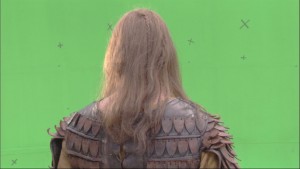
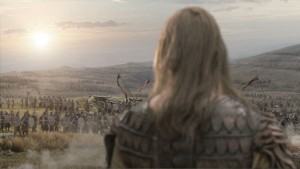
While the initial set of shots was slated to only be 100, Edwards found himself in offline with his laptop inventing shots to solve editorial problems. While this technique worked extremely well and gave Edwards his only big break – a completely locked-off edit from offline that the producers agreed not to change – it did see the shot count shoot from 100 to 250 shots. sensing the enormity of the task, the producers did reschedule post from three months to four or five, but it was the locked edit and Edward’s own self-discipline that made such a difference. For instance, in approaching the visual effects shots, Edwards could be confident that if a castle was only seen in a couple of shots from the side then he only had to make and texture that side and never made a full castle.
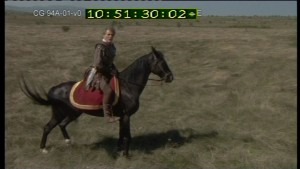
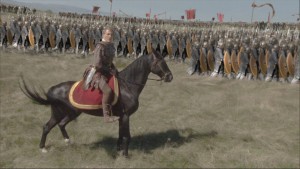
“There are just over 250 visual effects in the film, all of which were created by myself from home, mainly using After Effects & Photoshop,” says Edwards. “I had about four months of post time to do this which worked out to nearly 2 shots a day!” Edwards, using what one might consider an “Adobe Dream Team”, would develop a system for tackling the mountain of work in front of him starting with waking up each morning:
Step One: He allocated himself a roster of shots, aiming to start two new shots each day. and finish them by the time he went to bed. He would wake up, look at the day’s shots, and immediately try doing the “crappiest” version of the visual effects he could in around half an hour. There would be only the slightest hint of roto at this stage nothing remotely final.
Step Two: Edwards would work and render in After Effects but then place the shot in context in a version of the final edit, using Premiere. Using the Dynamic Link capabilities of the Adobe suite, as he refined the shot and re-rendered, it would automatically update in Premiere. This greatly simplified the process of allowing him to always judge the shots in context.
Step Three: Edwards would sit down with a piece of paper and a pen and write down all the things that seemed important in the context of the edit. He would create an ordered list of things to be done, based on editorial and visual issues. For example, if the cut had the viewer’s eye hard left of the frame, he would focus his effects on that side of the screen to make sure the area most likely to be seen next after the cut, and the best effects. If a castle would be partly hidden by a soldier this would save him having to texture it all or make a complete matte painting.
Step Four: He would then set to work on the shot, each one tracked with the new Imagineer tracker mocha-AE. mocha-AE allows one to export solid 4-point tracks, giving position, scale, rotation, shear and perspective matched tracks to Adobe After Effects. Edwards saw Mocha as a key aspect of being able to track all the shots for the budget.
Step Five: The shots would be worked on in After Effects, but immediately reviewed in Premiere. Edwards points out in a self-effacing manner that the shots would not stand up to repeated looped viewing – but that is not how he knew the audience would view the film. He designed and reviewed the shots in Premiere to work in the cut for only the duration of the cut. This flies in the face of “pixel-f*cking”, where directors loop and step frame through every single element – making visual effects artists jump through hoops. By working to a budget, a schedule, and a target viewing experience Edwards would often times finish epic shots and then go to bed.
Step Six: Repeat for 4 months.
For another sequence, “we basically built a large greenscreen in the middle of the woods in Bulgaria,” says Edwards. “We shot the whole sequence handheld, then I tracked it later and put the background in. The background is a high-resolution composite of lots of guys fighting. There are supposed to be tens of thousands, but we just used 4 guys!”


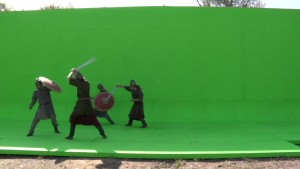
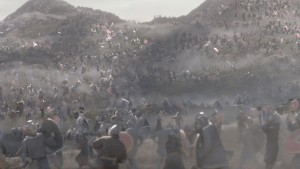
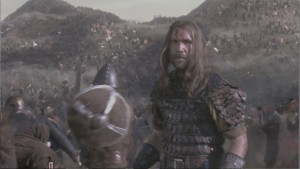
To give an example of the scale, in one of the signature shots of the project 30,000 Huns storm across an open field in an aerial crane shot. Edwards had just 7 guys and no use of specialist software like Massive. “The film itself was shot in Bulgaria over 3 weeks,” says Edwards. “For one of these weeks, two friends of mine flew out to supervise a greenscreen 2nd unit shoot with the extras, which basically consisted of filming hundreds of generic greenscreen elements for me to put together later.”
The team tried having actors run on treadmills, but the balance point for running on a treadmill is completely different from running over hard ground. Having rejected the treadmill approach Edwards built a long green screen and then used a long lens to film the seven guys running in front of it. Shooting with a long lens over several days of costume changes, Edwards just barely got what he needed. Even with a long green screen, they managed to normally isolate only one full run cycle. These looped single two steps were then stabilised, and placed on digital cards in 3dsMax.
To generate the armies, be did a sprite animation of the textured cards. The sprites moved simply over a 3D background. To break up the patterns several layers treated the sprite particle animation. A random grey version allowed for randomizing of the individual actor’s levels. Then an overall cloud pattern fell to produce large areas of light and shade over huge areas. To make the sprites sit in the shot, an ambient occlusion pass was rendered and the dust pass was added. The whole army was composited over a matte-painted motorway shot from a helicopter, and a simple projection map, and camera mapping technique were used to provide the huge camera move.
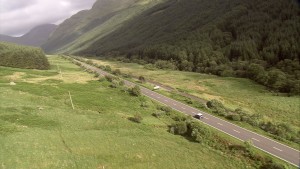
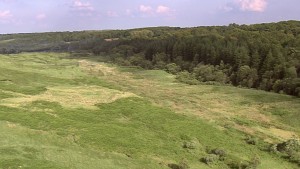
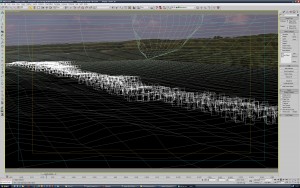
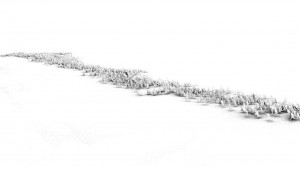
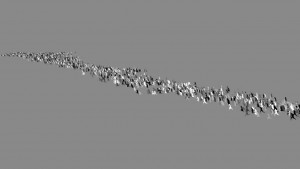
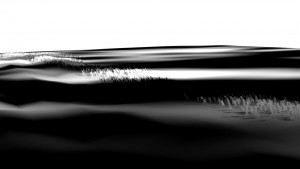
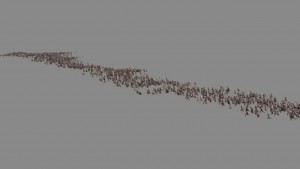
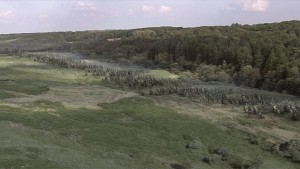

Really nice work …
And the One man Army was me 🙂 … The entire army in the image :
http://www.fxguide.com/wp-content/uploads/2010/10/08Feb/hun/aetius_army.jpg
is me walking again and again …Thanks for Gareth Edwards who made me look like that different .. 🙂
excellent work ! Congratulations Gareth !